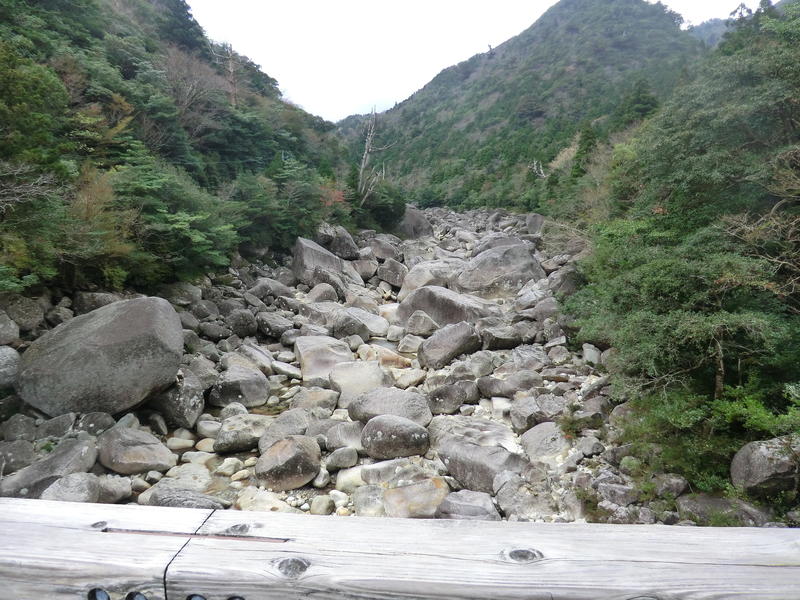Bulletin of the Geological Survey of Japan Top Page
Bulletin of the Geological Survey of Japan Vol.69 No.5 (2018)
Cover photograph | Table of Contents | Abstract
Cover photograph
Anbo River viewed from a tramroad, Yakushima Island
Miocene granite with large orthoclase crystals is exposed in the central part of Yakushima Island, surrounded by the Paleogene accretionary complex (Shimanto Belt). High rainfall produces well-developed streams on the island. Soil layers are thin and undeveloped because the weathered surface soil has been selectively washed away due to steep terrain and annual rainfall of over 4,000 mm. Most river beds are covered by boulders, some of which have a diameter of a few meters, with slight amount of sand (see the photo). Creating a geochemical map is challenging in Yakushima Island because chemical analyses are conducted using fine sand, but the map is expected to provide fundamental information to protect its native ecosystem.
(Photograph and Caption by Atsuyuki Ohta)
Table of Contents
All the pages PDF : 69_05_full.pdf [5MB]
| Title | Author | |
|---|---|---|
| Report | ||
| Geochemical mapping of remote islands around Kyushu, Japan |
Atsuyuki Ohta(p233-264)
|
69_05_01.pdf [3.8MB] |
Abstract
Geochemical mapping of remote islands around Kyushu, Japan
Atsuyuki Ohta
This paper describes high-density geochemical mapping of isolated islands in southwest Japan. A total of 193 stream sediments and three volcanic ash deposits collected from isolated islands around Kyushu were analyzed to determine the content of 53 elements to supplement land and sea geochemical mapping of the Kyushu area and regional Sr isotope mapping. The relationship between the spatial distribution of elements in stream sediments and volcanic ash deposits and the geology was closely examined using geographical information system (GIS) software. Stream sediments derived from mafic volcanic and pyroclastic rocks and volcanic ash deposits were enriched with MgO, CaO, Sc, TiO2, V, T-Fe2O3, Co, and Sr. The presence of alkaline mafic volcanic rock increased the concentration of Cr, Ni, Nb, La, Ce, Pr, Nd, and Ta in stream sediments. Stream sediments originating from granitic rock were abundant in Be, Na2O, K2O, CaO, Sr, Y, Sn, Ln, Th, and U. Accretionary and non-accretionary sedimentary rocks caused an increase in Nb and Ta concentrations in stream sediments, and a reduction in Na2O, MgO, CaO, and Sr concentrations. These geochemical features could be explained by the relative abundance of major rock forming minerals (such as quartz, plagioclase, K-feldspar, and mafic minerals) and accessary minerals (such as apatite and monazite) derived from the host rocks. Also, Zn-Pb deposits increased Zn, Cd, and Pb concentrations in stream sediments on Tsushima Island, and Sb deposits enhanced the Sb concentration in stream sediments on Amakusa-Shimoshima Island.
Geological Survey of Japan, AIST
- About GSJ
- Our Activities
- Purchase guide
-
Publications and Database
- information
- Bulletin of the Geological Survey of Japan
- bull2025(Vol.76)
- bull2024(Vol.75)
- bull2023(Vol.74)
- bull2022(Vol.73)
- bull2021(Vol.72)
- bull2020(Vol.71)
- bull2019(Vol.70)
- bull2018(Vol.69)
- bull2017(Vol.68)
- bull2016(Vol.67)
- bull2015(Vol.66)
- bull2014(Vol.65)
- bull2013(Vol.64)
- bull2012(Vol.63)
- bull2011(Vol.62)
- bull2010(Vol.61)
- bull2009(Vol.60)
- bull2008(Vol.59)
- bull2007(Vol.58)
- bull2006(Vol.57)
- bull2005(Vol.56)
- bull2004(Vol.55)
- bull2003(Vol.54)
- bull2002(Vol.53)
- bull2001(Vol.52)
- Bulletin of the Geological Survey of Japan(old)
- Annual Report on Active Fault and Paleoearthquake Researches
- Reports, Geological Survey of Japan
- CCOP-GSJ Groundwater Project Report
- CCOP Technical Bulletin
- Cruise Report
- Geological Hazards
- Learning and Education
- GSJ Database Collection
- Collection of links


